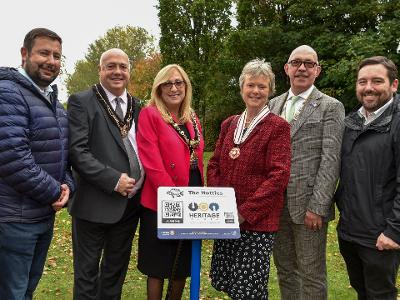St Helens' rich history recognised through heritage plaque trail
A dozen plaques are to be installed around St Helens town centre over the coming months to create a heritage trail to celebrate the town's proud history.

Article date: 13 October 2022
In a partnership between St Helens Borough Council and St Helens Rotary Club, the initiative is a short to medium target of the council's St Helens Borough Heritage Opportunities plan - a bold and ambitious vision for the borough's heritage over the next ten years.
The first of 12 plaques, each containing a QR code for people to scan to obtain key historic information, was launched at the 'Hotties' - a section of Sankey Canal, England's first canal of the Industrial Revolution which opened in 1757 to carry coal.
St Helens R.F.C. - who recently made history by becoming the first Super League team to win four consecutive Grand Finals in a row - will be honoured next when a plaque is unveiled at the Totally Wicked Stadium, scheduled for Monday 17 October as part of the club's 150th anniversary celebrations - with further plaques planned for the iconic Gamble Building, Beecham Building, St Helens Town Hall, Central Station, Parish Church, Quaker Meeting House, Cannington Shaw, St Helens and Runcorn Gap Railway - and in the middle of St Helens town centre where heritage and culture will play a key role in once-in-a-lifetime regeneration plans.
Once all twelve 12 plaques have been completed, other locations outside St Helens town centre will be explored, including churches, former mining sites and ward areas with rich heritage.
Councillor Anthony Burns, St Helens Borough Council's Cabinet Member for Wellbeing, Culture and Heritage said:
"St Helens borough is built on heritage and has been at the forefront of significant moments throughout British history. From the birthplace of the railway and first modern canal to innovators in glass and pharmaceuticals - and of course, home to the most successful rugby league team in the Super League era - so it's absolutely right that these achievements should be celebrated and on display for all to see.
"As a council, we're committed to protecting our heritage assets which is evident through the recent external works to restore the Gamble Building which forms part of this fascinating trail - and over in Newton-le-Willows where work is ongoing to bring the grade II listed Earlestown Town Hall back into use.
"By 2030, we want to have achieved national and international recognition for the significance, quality and management of our heritage assets, attractions, and infrastructure - and initiatives like this are a big step forward in the right direction."
Paul Winstanley, President of St Helens Rotary Club which next year celebrates 100 years of supporting the local community, added:
"The purpose of the St Helens Heritage Trail is to increase the whole community's awareness of how St Helens became a unique, pioneering and innovative industrial town taking its place on the world stage. It is hoped that the trail will stir up a sense of identity, self-worth and hope throughout the borough. It can also serve to benefit our local economy by attracting more visitors.
"This unique town of ours has a wealth of heritage shaped by the Industrial Revolution. The natural resources of coal, sand, water and location provided the foundations for industry to grow which led to England's first industrial canal, a significant section of the world's first passenger railway and being the world's first mass glass manufacturer. Innovation still plays its part in St Helens Borough today and these heritage sites will invite residents and visitors on a journey of discovery through 'looking back, looking around and looking forward together'. The Heritage Trail can help all generations to appreciate how their future and the future of our town continues to build on our proud heritage."




